Judging the OES
Judging the Old English Sheepdog
Written by Breeder Judge, Mary Anne Brocious for ShowSight Magazine, May 2012.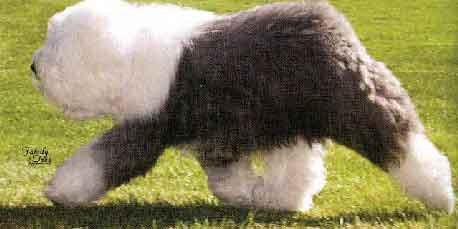
The Old English Sheepdog (OES) was developed as a drover's dog to move cattle long distances over rough terrain. Today, the OES is active in Companion and Herding events using its sturdy, square, agile structure; as a family companion with an adaptable, intelligent disposition with no sign of aggression; and of course the Conformation Ring where the striking picture of a balanced dog in full double coat makes him a standout.
The OES is often the last breed Herding Judges elect to judge within the Herding Group. The profuse coat deters people from judging the OES, as it takes time to become familiar with using your hands to measure and find both the correct and incorrect qualities hidden by the coat. The OES has many of the usual canine characteristics, but the hands must be used to find the features distinct to the OES. The hands must become your eyes as you visualize the structure beneath the coat. Picture these attributes in your mind's eye as you examine each dog.
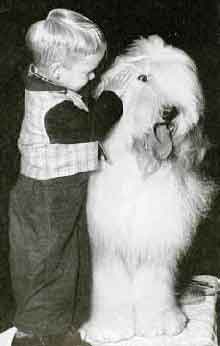 Temperament
Temperament
As in most breeds temperament is outwardly observed. The OES is "an adaptable, intelligent dog of even disposition" with "no sign of aggression, shyness or nervousness". Never reward a dog that demonstrates any indication of aggression, shyness or nervousness.
General Appearance and First Impressions
First impressions of a correct OES are a "strong, compact, square, balanced dog" that is "thick-set, muscular and able bodied". His ability for an instant takeoff, speedy gallop, quick turns, twists and reverses enables him to do the job he was bred for – he is a herding dog.
To live up to his potential, the OES must be sound and well balanced. The uniqueness of the breed comes in several important areas. He is short backed and very compact, yet he moves out with strong, powerful reach and drive. If viewed from above one would notice he is pearshaped, and narrower in the front with a broad rear. The very stout, gently arched loin and round muscular hindquarters, with well let down hocks, enables him to move tirelessly in any gait. He stands higher at the loin (not the hip) than at the withers. Hidden under the shaggy coat is a sound, well balanced, energetic, athletic and sweet tempered herding dog.
"To live up to his potential, the OES must be sound and well balanced.
The uniqueness of the breed comes in several important areas."
When judging appearance, the old adage "looks can be deceiving" can, at times, fit the perfectly groomed OES to a T. It is of utmost importance for judges to feel for the distinct characteristics that define this breed. The mental pictures obtained from the hands on examination, combined with the overall visual appearance, should simplify the choice. Grooming can hide a multitude of faults and hide correct structure. It is imperative that judges look past the grooming and feel for correct structure.
Size, Proportion and Substance
Height is measured from top of the withers to the ground. Dogs are 22" and upward and bitches are 21" and upward. The vertical measurement from the top of the withers to the ground and the horizontal measurement from the point of the shoulder to the ischium should be equal. Dogs are not necessarily larger than bitches. A dog should be masculine and balanced, and a bitch should be feminine and balanced.
The overall picture of the OES should be one to suggest squareness. The balanced dog does not have one outstanding feature or any glaring faults. He is neither long and low, nor tall and short backed. He is well balanced and is eye pleasing by his nicely proportioned features that are in correct relation to one another. The height of an OES is nearly 50% from the top of the withers to the elbow and nearly 50% from the elbow to the ground.
Size and proportion are absolutely independent of one another. Squareness, balance and correct proportions are just as necessary in a 21" bitch as they are in a 28" dog. Regardless of height, the dog must be square. Proper balance and dimension are two important pieces in the overall correctness of the dog.
The bone must be in proportion to his size and substance. An OES should feel sturdy. His loin should be muscular and broad. The amount of substance should be in proportion to the size of the dog.
Head
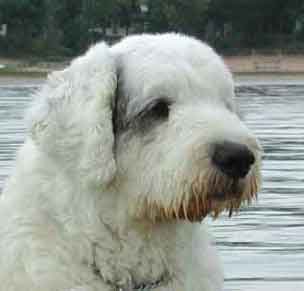 Though the first line of the Standard regarding head says, "A most intelligent expression", this is difficult to discern considering the head is well covered with hair. Again, the hand must determine the correct shape and details of the head. The skull is squarely formed and to be squarely formed, the width of the skull will be approximately the length from the stop to occiput. The skull is neither too flat nor too dome shaped. The head and the muzzle as a whole are squarely formed, not just the top. Both should exhibit good depth.
Though the first line of the Standard regarding head says, "A most intelligent expression", this is difficult to discern considering the head is well covered with hair. Again, the hand must determine the correct shape and details of the head. The skull is squarely formed and to be squarely formed, the width of the skull will be approximately the length from the stop to occiput. The skull is neither too flat nor too dome shaped. The head and the muzzle as a whole are squarely formed, not just the top. Both should exhibit good depth.
To assess the skull and stop start by placing the heel of your hand on the muzzle between the nose and stop and moving forward to feel for the degree of stop. Continue by using your thumb and fingers as you go up over the eyes checking for the well-arched supra-orbital ridges and a square, capacious skull. Large and square is important for the skull to be correct. One or the other of these characteristics is not sufficient.
When judging the jaw/muzzle we find Webster's definition of "truncated" as having the end square, cut short and curtailed. While the jaw should be fairly long, a judge should pay particular attention to a long narrow tapering muzzle, as this is considered a fault. The square muzzle should be deep and attach to the skull with bone fill under the eyes and into the checks.
The head should fit the individual dog. The general appearance of the OES is "a strong, compact, square, balanced dog". A 24-inch dog will not have the same size head as a 27-inch dog, but both heads should have the attributes as described above. It is a large head for the dog's size, but still remaining balanced with the rest of the dog.
Details of the head include a nose that is "always black, large and capacious". A nose that is flesh-colored or spotted is not acceptable. The Standard states, "always black" and there should be no excuses made for a dog that is old enough to be entered in a show to have a pink nose.
In addition, teeth are "strong, large and evenly placed. The bite is level or tight scissors". Eyes are "brown, blue or one of each. If brown, very dark is preferred. If blue, a pearl, China or wall-eye is considered typical. An amber or yellow eye is most objectionable". It should be noted that the use of wall-eye in the standard is a synonym for China and pearl. The brown eye must be dark and any shade of blue is acceptable. An amber (light brown) or yellow eye is objectionable. Pigmentation around the eye rims or lack of pigmentation should not be considered. Ears are "medium sized and carried flat to the side of the head".
Neck, Topline and Body
It is easy for a judge to be misled in the area of "fairly long, gracefully arched" neck at first glance. A good handler can make a great deal of difference in the way a dog is presented, as can a good hairdresser with a stripping knife give an illusion of an arched neck and the position of the withers being correctly located when the neck is not arched and the withers not properly set. A well-informed judge, after individual examination of each dog, knows which dog has the arched neck and which doesn't. As the hand is moved down the neck, an arch can be felt in the upper portion below the skull.
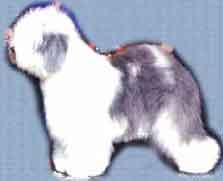 The OES topline is a unique characteristic. It is gently arched over a very broad and stout loin. The topline is not to be mistaken for a roached back, nor is it a swayback, with the highest point at the hip bones. The correct topline has a gentle rise at the highest point over the loin.
The OES topline is a unique characteristic. It is gently arched over a very broad and stout loin. The topline is not to be mistaken for a roached back, nor is it a swayback, with the highest point at the hip bones. The correct topline has a gentle rise at the highest point over the loin.
While judging topline, proper use of hands is again of utmost importance. This technique should give you the answer: Start by checking that the dog is stacked properly as this will affect the topline. With your hand placed at the withers, run it along the topline. You should feel a gentle rise as your hand moves toward the loin of the dog. The ribs should extend well back and the loin should be short and gently arched. The greater height at the loin than at the withers need not be extreme and should not be achieved by a sway back, by very straight stifles, or by unusually short front legs.
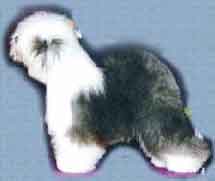 This is a characteristic that is unique to the Old English Sheepdog. Without it you do not have a correct OES.
This is a characteristic that is unique to the Old English Sheepdog. Without it you do not have a correct OES.
A deep brisket capable of housing strong lungs is required if the OES is to maintain the stamina needed for a day's work. The ribs should be well sprung, but not the point of creating a barrel-like appearance. Hands must be placed behind the elbows and brought along the contour of the dog's body. As the hands move over the ribs, a well-muscled dog must be felt.
The "tail is docked close to the body, when not naturally bobtailed". The Old English Sheepdog Club of America, Inc. has not prepared a position statement on un-docked OES. With the trends throughout the world with OES and other docked breeds, you may see one with a tail in your ring. According to the American Kennel Club, if the standard does not call for the disqualification of a dog that has a tail that is not docked, you must fault the deviation to the extent of the breed standard. The tail is docked.
Coat and Color
The OES has two distinct coats. The first is a thick soft undercoat next to his body and then a crisp, harsh, shaggy one outside. The outer layer is long and harsh. It is not in the least curly, neither is it, to any degree straight. It is rough-surfaced and wiry. Above all, the OES coat should look shaggy and convey an impression of growing profusely in all directions. Underneath the outer coat is a dense thick coat of waterproof pile. Grooming may considerably modify both coats.
The presence of foreign substance is cause for dismissal from the ring. Teased heads, bodies and legs followed by a can of spray do not allow coat texture to be judged. You should not see a dog go around the ring with the legs moving, but not the hair! Today some dogs are over groomed and the Standard clearly states that this is incorrect. A poor specimen should no be rewarded over a superior one simply on the basis of grooming. An OES should be clean, brushed out and free of mats.
The correct color of the OES coat may vary in shades of blue, grey, grizzle or blue merle. Any shade of fawn or brown is objectionable and should be treated as such. There is positively no desired shade of color or markings. Splashed or flashes of white on the solid body markings have always been considered typical and should never be subject to penalty. A good dog is a good dog, regardless of markings.
No dog can be fairly dubbed too light or too dark in color if his coat does not contain shades of brown or fawn. Any shade of gray, grizzle or blue merle is correct as long as no shades of brown or fawn are present.
The depth of gray color is also a function of age. The very light, silvery gray of adolescence very frequently darkens with maturity. The difference in the shade of gray, be it light or dark, is not to be penalized.
A footnote to coat color is to identify sun bleaching and/or changing puppy coats. Sun bleached coats have temporary red or brown tinges to the ends. When dogs have a brown or fawn look to the coat, spread the hair apart to see the inner hair color. Check the puppy coat for the new guard hairs (texture) and more mature hair coming in. Young dogs may have coats that transition from soft black hair that may be somewhat brown. The transition coat can be light grey with brown, dead puppy hair. Look through the hair for incoming undercoat and coarse outer hair.
Gait and Movement
An Old English Sheepdog's effectiveness as a herding dog can be evaluated quickly and relatively accurately by watching how he moves at a trot.
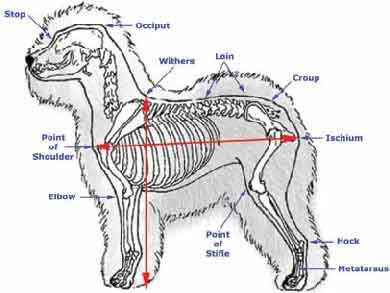 Looking at the OES, and the way he is built, one would not expect him to gallop well. Free to move with speed, he is an active, tireless galloper, covering ground quickly with apparently little effort. Unfortunately, you will not see the elastic gallop in the show ring.
Looking at the OES, and the way he is built, one would not expect him to gallop well. Free to move with speed, he is an active, tireless galloper, covering ground quickly with apparently little effort. Unfortunately, you will not see the elastic gallop in the show ring.
The OES must maintain balance, proportion, type and topline while in motion as when standing. The profile outline that is seen when a dog is in motion is very important when evaluating type as well as movement. It is the dog's balance, starting with the correct head carriage and continuing along the proper topline and croup, that creates a harmonious whole. This should work together with the breed specific stride – trotting, ambling or pacing.
A note on head carriage: the OES must have sufficient neck to carry its head. However, in the OES and many herding breeds, the head is not always carried up. What the OES is watching for is closer to the ground, so the head will often plane a bit lower. Carrying the head up is flashy in the show ring, but is not always correct for a herding dog.
Gait and movement are separate. Movement is the way a particular gait is executed. In the trot, for example, the movement should have good extension in the front and good drive in the rear. A dog with balanced angulation will have equal extension in the front and rear. The end result is a properly executed gait.
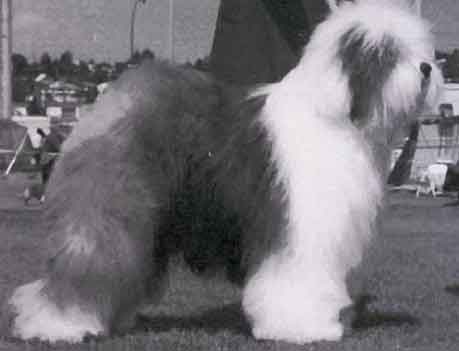 Coat may influence your perception of the way an OES is moving and you must learn to see through the coat in action. A lot of coat on the front may make a dog look out at the elbows or even a little sloppy. Likewise, don't be fooled by all of the hair on an overly wide front that does not converge. An untrimmed hindquarter can look close and markings on the legs may give a false impression of movement. Watch the pads going away.
Coat may influence your perception of the way an OES is moving and you must learn to see through the coat in action. A lot of coat on the front may make a dog look out at the elbows or even a little sloppy. Likewise, don't be fooled by all of the hair on an overly wide front that does not converge. An untrimmed hindquarter can look close and markings on the legs may give a false impression of movement. Watch the pads going away.
A Herding dog should move as though it could cover ground at a steady gait for long periods of time and never miss a beat or break down. He should be well balanced with good reach and drive.
The front should reach easily and smoothly without hitching, rolling, waddling or hackney movement. The rear drives straight back without any wasted motion (kicking up). A herding dog will drop his head and carry it forward as his speed increases; proper assessment of OES movement requires that the dog be shown on a loose lead, not "strung up" and at a moderate speed.
Trends
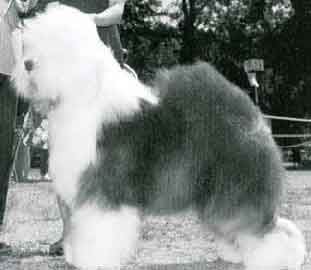 Please remember that the Old English Sheepdog is not a breed that has a particular outline scissored into it as does a Portuguese Water Dog, a Bichon Frise or Poodle. As the Standard states, "neither the natural outline nor the natural texture of the cost may be changed by any artificial means." Should an exhibit lack coat in the locations described in the Standard as "the whole skull wellcovered with hair", "the neck well-coated with hair", "the forelegs well-coated all around and the hams densely coated with a thick long jacket in excess of any other part", its grooming does not comply with the OES Standard. OES grooming should represent the "profuse", "shaggy" coat as described in the Breed Standard.
Please remember that the Old English Sheepdog is not a breed that has a particular outline scissored into it as does a Portuguese Water Dog, a Bichon Frise or Poodle. As the Standard states, "neither the natural outline nor the natural texture of the cost may be changed by any artificial means." Should an exhibit lack coat in the locations described in the Standard as "the whole skull wellcovered with hair", "the neck well-coated with hair", "the forelegs well-coated all around and the hams densely coated with a thick long jacket in excess of any other part", its grooming does not comply with the OES Standard. OES grooming should represent the "profuse", "shaggy" coat as described in the Breed Standard.
Judges Education of the Old English Sheepdog Club of America welcomes your questions and interest in our Breed. The OESCA appreciates judging that maintains the definitive qualities of the Old English Sheepdog and the integrity of the Old English Sheepdog Breed Standard.
Reprinted with permission from ShowSight Magazine, May 2012
ABOUT THE AUTHOR
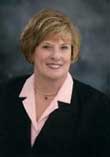 Mary Anne has experience as an exhibitor, breeder, dog club official and judge.
Mary Anne has experience as an exhibitor, breeder, dog club official and judge.
Mary Anne began breeding and exhibiting Old English Sheepdogs in 1973 and has bred and owned over 100 OES Champions under the Qubic prefix. Qubic OES have won BIS, BISS, many group wins and placements at AKC events and many have championships in foreign countries. At the 2012 OESCA National Specialty Qubic OES were Winners Dog, Winners Bitch, Best of Winners and Best of Breed. Qubic OES have received awards for Top Producing Sires and Dams and Register of Merit awards from the Old English Sheepdog Dog Club of America. While the breeding pro-gram has remained small, she is proud to have maintained high standards of health and temperament in her dogs.
Mary Anne has served as a club officer, AKC Delegate and is a Life Member of the Ann Arbor Kennel Club where she is currently Show Chair. Mary Anne serves as Judges Education Chair for the Old English Sheepdog Club of America. In 2013 Mary Anne was selected as Herding Breeder of the Year by the Santa Barbara Kennel Club. She is approved by the AKC to judge all Working and Herding Breeds, PBGVs and Best In Show. In addition to judging in the US, Mary Anne has judged in Australia, China, South Africa, Taiwan, Mexico, Canada, Germany, Denmark and Finland.




